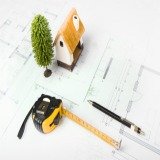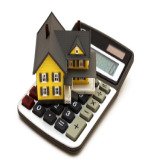The Cost Of Solar Panels
The cost of solar panels are one factor when you want to use green building materials and methods, and these panels have a number of considerations included in the total cost. Solar energy can be a very green and effective way to heat and power your home, and this method can save you a significant amount of money on your utility bills each month. Solar cells, panels, and systems available today are much better than those which were used in the past, with a much higher energy efficiency level so fewer cells and panels are required to get the same results.
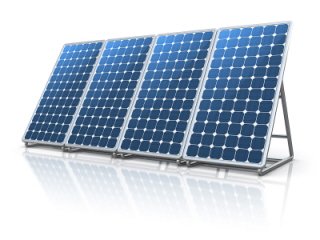 Calculating the total cost of solar panels involves more than just the solar panels cost and prices, there are other factors that need to be looked
at as well. Labor and installation may be necessary, and this is another cost you will need to pay to get the panels installed and working
correctly. Most of the time the solar panel prices can vary, depending on the size, type, and efficiency of the panel as well as the location
where the home is located.
Calculating the total cost of solar panels involves more than just the solar panels cost and prices, there are other factors that need to be looked
at as well. Labor and installation may be necessary, and this is another cost you will need to pay to get the panels installed and working
correctly. Most of the time the solar panel prices can vary, depending on the size, type, and efficiency of the panel as well as the location
where the home is located.
Solar energy can help lower your utility bills, save energy, and protect the environment as well. Another benefit is that you will always have power even if the grid is down, because all that is needed is solar energy which costs nothing to collect.
The History Of Solar Panels
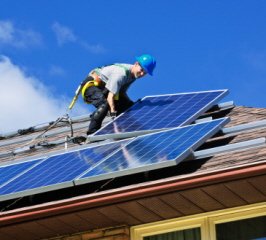
Solar energy has been used through history, and the very first solar cell was built in the year 1883, by a man named Charles Fritts. This cell was created by using a thin gold coating over selenium, which is a semiconductor. This solar cell was not very effective, with less than one percent efficiency, and the cost of solar panels using this method would be prohibitively expensive today.
Even before this point solar energy had been used to dry things, such as foods and other items, and for certain other purposes, but 1883 was the first year that success at creating a solar cell was documented.
The silicone solar cell was developed in the year 1941, by a man named Russell Ohl, and this had an impact on both the efficiency and the further development of solar panels. This silicone cell finally broke the one percent efficiency mark, and this breakthrough would have an effect on solar panel prices and sizes in the future.
In the year 1954 the first solar panel was created, by three men who were American researchers. These men, Calvin Fuller, Gerald Pearson, and Daryl Chapin, produced the first solar panels by arranging silicon strips in the direct sunlight, and then using the energy captured to produce electricity.
The cost of solar panels was initially very high, and few could afford to go green in this was. In 1955 the first solar or PV commercial system was introduced by Hoffman Electronics, and this system was rated at roughly two percent efficient. These initial solar panel prices were quite high at around twenty five dollars a cell, and each cell was only capable of fourteen megawatts. When the cost per watt of energy was calculated these panels had a cost of around fifteen hundred dollars per watt. In 1957, the development of cells by Hoffman Electronics reached eight percent efficiency.
Through the next forty years advances in technology have increased the efficiency of solar cells and panels, while reducing the cost of solar panels by large percentages. Today there are solar cells, panels, and systems in many different size, watt, and price ranges, ideal for any residential or commercial application. These options are becoming more popular as more people try to conserve energy and minimize their environmental footprint. Solar energy is one of the few green building choices that can help you warm and power your home without fossil fuel use or environmental pollution.
Solar Panel Prices
When you first look at the cost of solar panels and systems you may think that the purchase price is high, depending on your home size, the type of solar panels that you want, and your geographic location. There are different panel types, which may use different solar cell sizes and capabilities. The first place to start is by making sure your home is as energy efficient as possible.
This will reduce the cost of solar panels that you must spend, because your total energy use will determine how many panels are used and how large the system must be. Solar panels today are normally a minimum of twelve percent efficient, much higher than those found in the past.
It is possible to make your own solar panels, and this will usually cost around $200 per panel in many cases. To do this you must be able to follow the instructions exactly, but the cost savings that you see from using this method may be well worth the effort you put in. There are many resources available on the Internet that can help you build your own solar panels at a much lower cost if you choose to take this route.
The cost of solar panels has dropped significantly in the last four or five decades. At first these panels cost roughly $100 per watt, which is extremely high and far more than utility companies charge. As technology advanced the price of this green building option has come down a lot. Now it is possible to find these panels for as little as a few dollars per watt without installation costs if you choose to purchase pre-made panels. If you are handy then you may want to try and make your own solar panels, because this can cut costs even more and lower the price per panel by as much as half or even more.
The Cost Of Solar Panels, And The Types Of Systems And Panels Available
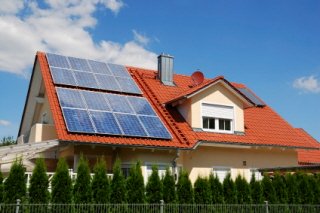
The cost of solar panels will be tied directly to the specific panel type that you choose. Solar panels come in a variety of types, and each has certain advantages and drawbacks involved. The most common types of solar systems for residential settings include flat plate collectors and evacuated heat tubes.
Flat plate collectors are normally seen on the roof of homes and buildings, and this is the most common type used for residences as well as many commercial properties. This panel type may be less efficient than the evacuated heat tube system, because there is a loss of heat and energy with the flat plate system due to the gap which exists between the cover and the absorber.
Evacuated tube systems will increase the cost of solar panels some, but these systems are also more efficient and effective at capturing all of the energy and preventing any loss. This type of solar power system usually runs between 25% and 30% more, but you will also see higher energy savings once the system is installed and in use. The tubes prevent any heat loss from the flat panels, so the system captures all of the available energy.
Solar panels also come in a variety of types and sizes, and these factors will help determine the cost of solar panels that you use. Solar panel types include:
Monocrystalline Panels - Monocrystalline panels use a single large sheet of crystalline silicone, and then metal strips which are the conductors are laid over the panel. With this type of solar panel the sheet of silicone creates a single cell. This panel is a little more efficient than the polycrystalline type, but usually costs about the same making it a better choice in many situations.
Polycrystalline Panels - This type of solar panel involves the use of many smaller cells, instead of a single cell covering the entire panel. Because many small cells are used instead of a single large cell there is a small loss of effectiveness when compared to monocrystalline panels, although the solar panel prices of both types are about the same. This type of solar panel may involve cast polycrystalline panels or string ribbon silicone. Both of these types start out using molten silicone.
Cast Polycrystalline Panels - With cast polycrystalline panels the panel manufacturing process starts with silicone which is molten. This silicone is used to produce a large block of the material which is then cooled. This block is cut into wafers that are extremely thin, and these wafers are used to create the solar cells. The panel is created by assembling the required number of cells into a panel. After the cells are arranged metal strips are placed over the cells for conduction. The metal strips connect each of the cells together and form an electric current which is continuous through the solar panel. These solar panel prices may be somewhat higher than string ribbon silicone panels.
String Ribbon Silicone Panels - These panels also start out with a molten silicone material, but the process used is different. The liquid silicone is drawn out into crystalline silicone that is in the shape of a thin strip. These strips are arranged on the solar panel, and then the metal strips are added, so that each strip is connected and the electrical charge covers the entire panel. The solar panels cost for this type can be higher, even though the production costs are usually lower because not as many steps are involved. There are some technologies used which can make string ribbon panels more efficient than other types, but this is dependent on the specific process used to make the string ribbon.
Thin Film Panels - The process used to make thin film solar panels is not the same as those used in crystalline panels. Thin film panels use a silicone material which does not form a crystalline structure, and instead the material is used as a thin film coating right on the solar panel materials. Some of the technology used to create thin film panels may include other materials which are semiconductors as well as silicone.
The metal conductor strips connect the semiconductor materials, but these panels do not always use the other common components found in a PV panel. This means that these panels are more durable and not as fragile, because there are no crystals involved. These panels do not have to be as protected as the crystalline types. Thin film panels offer a lower cost and more versatility, but they can also be the least efficient. The silicone used may have high impurity levels, and over the life of the panel the effectiveness can decline quickly.
Ideal Panel Types By Region
Northern USA - In the northern United States region there are fewer hours of sunlight than in the southern region, and this will impact the best type of solar panels to use. In these conditions the best type of panel to use is usually monocrystalline panels, because of their high efficiency level.
Southern USA - Most areas and homes in the southern region of the USA can benefit from almost every type of solar panel. The southern region usually receives the most direct sunlight throughout the year, and may have significant sun even in the winter months. This means that even less efficient panels will normally work well in these areas because of the high amount of sun that is available all year long.
East Coast - The east coast of the United States can vary greatly when it comes to the amount of sunlight available on average. Along the southern part of the coast there may be much more sun than the northern areas of the coast, and this can have an effect on the right choice of solar panel.
A qualified solar company can help you determine the best panel type according to your specific location along the coast. In some homes a polycrystalline panel may work well, but others may require a monocrystalline panel to provide the right amount of energy due to decreased sun during the winter months.
West Coast - The west coast of the United States receives quite a bit of sunlight all year long in the southern areas, but the northern part of the coast may be affected by less sun and more cloud cover. While the southern areas may be able to use thin film panels locations in the northern coastal areas may require polycrystalline or monocrystalline panels to be the most effective because of the lower light levels during part of the year.
Key Elements
Positive Cost of Solar Panels Features
- Federal tax credits
- State tax credits in some states
- Lower energy bills
- Sale of any unused power generated to the utility company
- The initial cost of solar panels is recovered over time
- No environmental pollution
- A 25-30 year life with many panels
- Price has declined significantly while efficiency level has risen
- As fossil fuel costs rise so will your savings
- Sunlight does not cost anything
Negative Cost of Solar Panels Features
- The initial purchase cost may be high, sometimes running up to one hundred thousand dollars for a very large home with high energy needs
- Installation costs are additional
- The most efficient panels usually cost more
- Crystalline panels are fragile, so they require additional protection and can be easily broken
- Thin film panels are less fragile, but are also less effective
You Might Also Like:
Home Design Floor PlansHome Design Floor Plans |
Green Home DesignsGreen Home Design |
Boat Home PlansBoat Houses |








